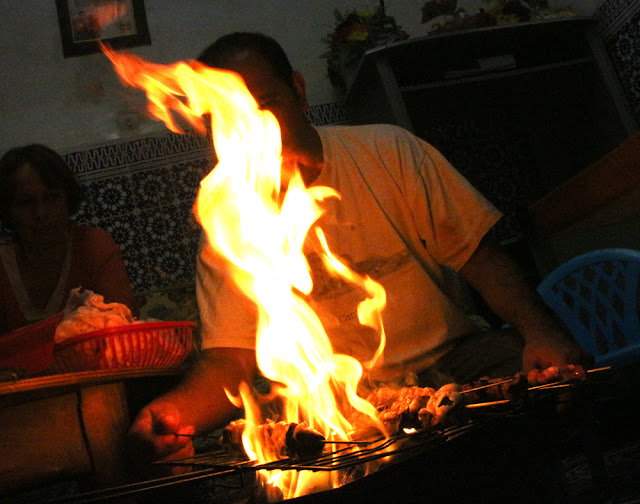An unusual festival called Boujloud (sometimes "Bo Abatain") takes place in some areas of Morocco during the days following the celebration of Eid al-Adha. It involves individuals wearing the skins of rams, and roaming the neighbourhood streets, going from door to door asking for money or sheep and goat skins. Some say that to touch the skin being worn can bring good fortune. If it sounds familiar, then it is probably because it is an ancient echo of halloween.
But the festival is not without its critics because of a number of problems. Some critics claim that the Boujloud festival has no cultural value and that individuals use it as an excuse for anti-social behaviour. The critics say it has lost its heritage value and that being dressed in goat skins hides the person's identity and so they feel free to harass girls and demand money.
Researchers, however, say the custom is ancient and has its origins in Africa, inspired by the legends of a leather-clad monster that terrorised people in remote areas. It may also have reflected a tribal raiding party dressed in skins.
 |
| Some believe that lighting a fire in a house during Eid brings bad luck |
Another custom associated with Boujloud is a prohibition on lighting a fire inside a house in order to cook the meat on the day of Eid. Some people insist that lighting a fire at Eid ruins the sanctity of the day, as does working. This belief is held by many in the south of the country where one researcher claims people are fearful of lighting a fire, believing that it will lead to their death.
But beliefs and superstitions aside, there are even more cogent reasons to question such celebrations. Each year the Eid celebration costs Morocco huge sums of money, almost 300 million dirhams, and also 1500 working days per year, due to poor handling of the skins animals sacrificed during Eid al-Adha.
According to experts from the Moroccan Leather Industry Association, on the one day of Eid the industry lost nearly four million sheep or goats skins out of an estimated five million - a loss of about 40 percent of Morocco 's skin consumption for clothing and footwear, in a single day. Something that could be avoided if people understood the importance of cleaning, salting and storing skins in the shade to avoid rotting.
 |
| "Heading the message" - Fes residents make certain the skins are ready for tanning |
Such is the extent of the problem that a campaign has been launched to raise awareness of the importance of the skins from the sacrificial feast. The campaign has brought together not only leather industry specialists, but also veterinarians and imams from Morocco's mosques. As a result of the poor handling these skins, Morocco is forced to import around one billion dirhams worth of leather annually from France and Italy.
Some Arabic language news sites report that the future of the ancient festival is "between a rock and a hard place" because of all the controversy.
While Boujloud is not celebrated in every area of Morocco it can be found in places such as Tiznit, Agadir and Amazigh regions in the south of the country and the Rif Mountains in the north. The festival is notable because of the participation of both males and females. In some area the festival has been turned into a local carnival lasting up to seven days and expanded to include concerts of folk music. This change has made Boujloud into a cultural event that highlights the Amazigh cultural heritage and attracts thousands of tourists who come specifically to see the "Carnival Boujloud ".
SHARE THIS!






1 comment:
C'est peut-être de là que vient le célèbre nom de la place Boujloud à Fès. En tout cas c'est plus fantastique que la référence militaire plus terre à terre...
Bonne journée!
Remarque : il est souhaitable de changer votre anti-spams qui est vraiment compliqué et souvent illisible. Il faut recommencer plusieurs fois avant de réussir à faire passer le commentaire!!
Post a Comment